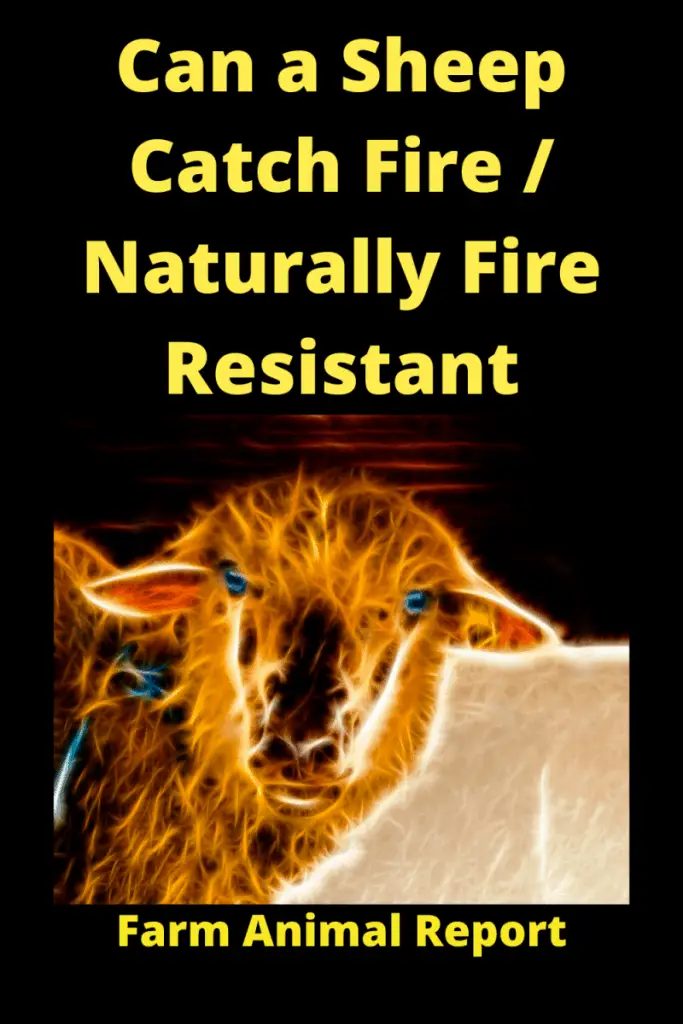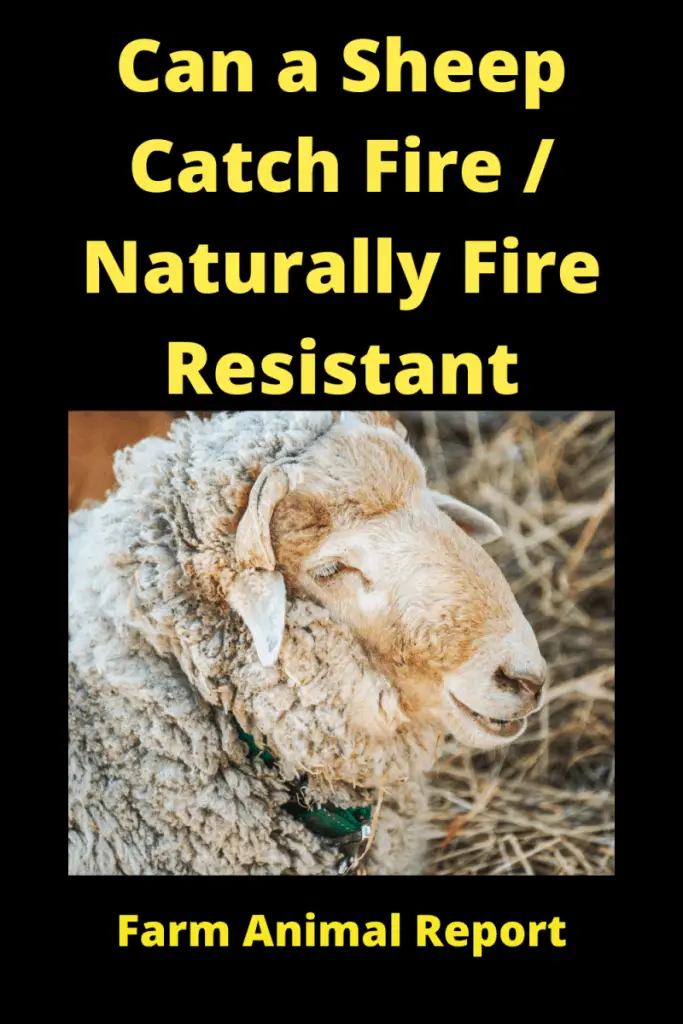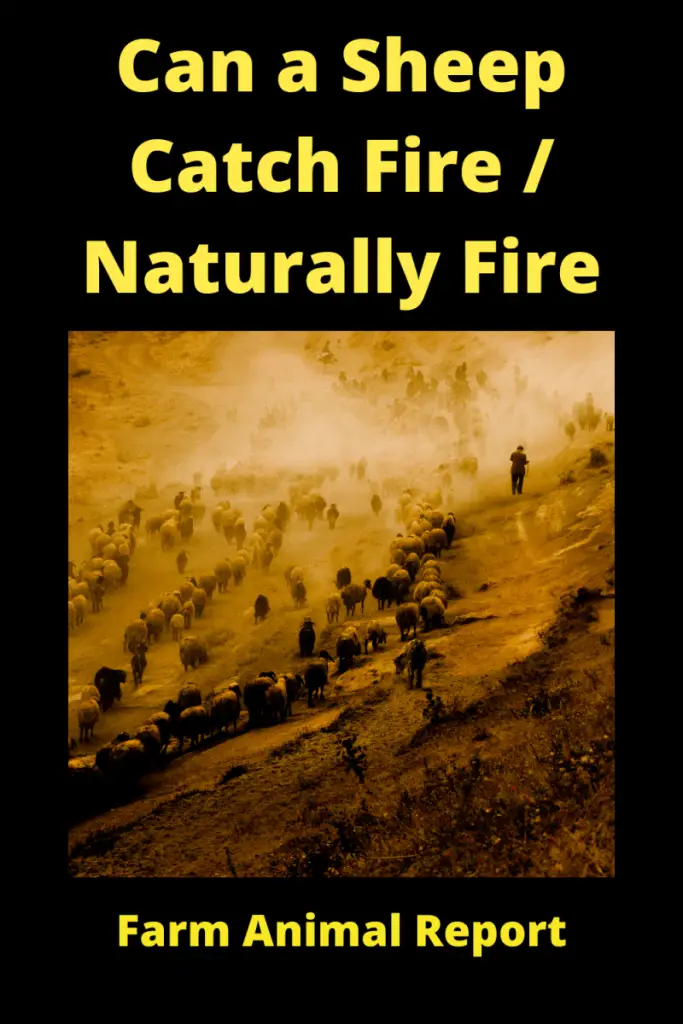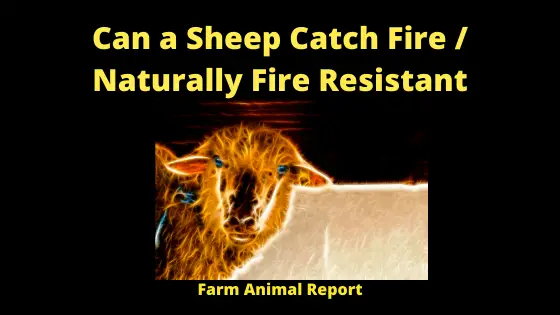As a general rule Wool is naturally flame-resistant and offers a greater level of fire safety than other fibers. Besides, wool doesn’t melt, drip, or stick to the skin when it burns. Wool’s inherent fire resistance comes from its naturally high nitrogen and water contents, requiring higher levels of oxygen in the surrounding environment to burn. Wool may be ignited if subjected to a significantly powerful heat source but does not normally support flame, and will instead smolder, usually only for a short time.
Can a Sheep Catch Fire
Can a Sheep Catch Fire – Sheep wool is a great material. It’s a natural insulator, locally grown, sustainable, and breathable; it dampens sound and is fire safe.
Check Out Amazon Educational Resources for Raising Sheep
Benefits of Sheep Wool
With an ever-greater choice of insulation on the market and a growing awareness of the many roles insulation plays, it’s worth considering the most effective options for your application. The use of natural use of fiber insulation is growing rapidly.
Making the Thermaflecce:
The wool’s cross-linked cell membrane structure will swell when heated to the point of combustion, forming an insulating layer that prevents the spread of flame. This also means that wool produces less smoke and toxic gas than synthetic fibers.
Wool’s flame-resistant properties make it an ideal fiber for interiors such as carpets, curtains, upholstery, and bedding, helping to reduce the risk of fire spreading within a house, and used widely in personal protective equipment to protect firefighters, military personal, and anyone else exposed to fire or explosives.
Wool’s characteristic of only smoldering and not melting or dripping onto skin, can itself be a lifesaver.
The sheep’s wool is a good kind of insulator. That’s why we use it to make thermal fleece. Thermafleece is manufactured in the UK and combines British wool with recycled polyester to create effective, safe, and sustainable insulation.
Thermafleece provides heat insulation in several ways. It acts like other insulation in preventing heat loss by limiting air movement; it also prevents heat gain during peak summer months. This is due to the relatively high heat capacity of sheep’s wool that allows the insulation to absorb and store heat and release it much later in the day as the temperature cools.
Natural fibers such as sheep’s wool are breathable, meaning they can bind and release moisture allowing thermal fleece to act as a humidity buffer. This helps protect structural timber elements from moisture, providing a stable fabric. This is particularly appropriate in the more damp and humid climate of the British Isles.
Breathability is very important in older properties, but using sheep’s wool insulation isn’t just limited to historic and period properties. You can use thermal fleece almost anywhere in the building. It can be used alone or combined with most other types of insulation to improve thermal mass, breathability, acoustics, or to reduce the environmental impact of the building fabric.
Acoustic Properties
The acoustic properties of natural fiber insulation are often overlooked. Because of their irregular surface, shape, and density, fibers such as sheep’s wool are very effective at disrupting sound. That’s one reason sheep’s wool insulation can provide acoustic performance comparable to the best mineral fiber products.
How materials react to fiber is an increasingly important consideration. Sheep’s wool a high ignition temperature and reacts to fiber by charring. To improve these natural characteristics, the wool in thermal fleece is treated with a low level of borax to ensure our insulation is fire safe. All thermal fleece products pass British Standard tests for smolder resistance and flammability.
In the past, natural fiber insulation has been seen as the most expensive choice and difficult to get hold of. That’s no longer the case. Thermafleece is widely available throughout the UK thanks largely to a large network of distributors and merchandise. In many cases, systems incorporating thermal fleece have a lower cost than alternative systems.
Assessing Sheep after a Fire:
Sheep are common victims of fires in Australia. The information below describes how the fire may affect sheep, and the management option landholders have.
We supply this information to assist managers affected by the fire to make livestock decisions.

Care for Sheep and Yourself after a Fire:
During a fire, often large numbers of sheep are affected when they mob themselves into corners of paddocks against fences, where they are burnt or suffocate. Burns sustained often reflect this behavior, with animals on the outside burnt around the face or tail, and those in the middle may completely escape injury.
Wool is a good insulator, protecting the sheep’s body from intense radiant heat. Sheep in full wool are less likely to suffer severe burns than sheep off shears. The outside of the fleece can be quite charred, yet the underlying skin may be completely unaffected.
Emotions can run high during and after a fire: getting professional animal health and welfare advice can support sound decision making.
See Our Extensive Guide – 16 Ways to Make Money Sheep Farming
Initial Assessment:
Sheep able to walk should be yarded for assessment, usually the day after the fire or when it is safe to enter the property.
After a fire, teams from the Department of primary industries and regional development (DPIRD) are assigned to assess property damage, deal with animal welfare needs and refer any human welfare concern to the appropriate agency. The team will assess livestock and destroy those animals assessed for euthanasia.
Animals Caught in a Fire can be Divided into Four Groups:
- Category 1: destroy immediately
- Category 2: salvage slaughter
- Category 3: keep and nurse
- Category 4: animals with no apparent damage
Other things to Assess Are:
- Availability of feed and water
- The owner’s ability to provide necessary care and attention
- The prognosis for productive and reproductive performance of livestock.
Category 1: Destroy Immediately:
Sheep for humane destruction at the stage include:
- Sheep that are unconscious or semi-conscious
- Those down and unable to walk
- Those with extensive burns to bare areas
- Those with major swelling of the limbs
- Those are showing respiratory difficulties from smoke-damage lungs.
Category 2: Salvage Slaughter:
Moderately burnt sheep that will survive at least the next few days after a fire may be worth slaughtering for sale or use. These animals may be heavily singed on the wool with only minor burns to the non-wool areas. The non-wool areas include the face, ears, lips, forelegs, teats, anus, and between the legs.

Take note:
- It is very unlikely that animals in this category will be fit for transport. If there are any doubts about the health or ability of the stock to cope with being transported, they should be assessed by a veterinarian or recognized DPRID staff member or not transported.
- Bare areas with hardened cracking skin usually have subcutaneous edema and congestion, causing difficulty with skinning and can result in carcass consideration.
- The condition of even mildly burnt sheep can deteriorate rapidly. This needs to be considered when large numbers of sheep are affected, and abattoirs are oversupplied.
Category 3: Keep and Nurse:
Mobile and alert animals with only moderate burns to less than 10-15% of their body are generally good candidates for keeping.
Make sure you:
- Consult a veterinarian about the treatment of burnt sheep that are suitable to keep secondary infection following burning is likely.
- Have suitable facilities, labor, freshwater, and feed are readily available. Treatment and recovery are likely to belong and arduous, with no guarantee of success.
- Inspect the sheep each day for at least a week after being burnt, and those seen to be deteriorating or unable to drink should be humanely destroyed. Regularly check all animals, on burnt areas of the body and the feet, for signs of flystrike.
- Provide high-protein feed when the burnt sheep are ready to eat to aid healing.
- Place sheep on soft, level ground, especially if their feet are burnt. Sheep with minor visible cracking around the coronet will be very lame and sore.
Suppose these sheep need agisting, and there are any doubts about the health or ability of the stock to cope with being transported. In that case, they should be assessed by a veterinarian or recognized DPIRD staff member, or they should not be transported.

Category 4: Animals without Apparent Damage:
These are sheep that are undamaged or have minor singeing of the wool and facial area and have sound feet. They should survive but must be re-assessed in 5 to 7 days. Pay particular attention to breathing difficulties caused by smoke inhalation, which may take some time to become evident. The stock needs to be yarded to inspect the sheep properly.
What to look for:
Severe burns in sheep are generally confined to the bare areas of skin, not protected by fleece wool: the udder, anus, vulva, lips, nose and face, belly, and most importantly, the feet and legs.
Severe burns may not be obvious immediately after a fire, but after 2 to 3 days, the skin appears dry, scorched, and leathery. There is often swelling and release of fluids or sloughed skin.
Feet and Legs:
The most important factor for survival is mobility. Often after a fire, sheep are forced to stand on the burnt ground, resulting in hoof injuries and leg burns sustained in the fire. Severely damaged legs will be swollen, and the skin leathery with underlying tissue damage. These animals eventually go down and unable to rise or walk to water and feed sources die.
If hooves are lost, the animals must be destroyed, regardless of other burns. Walking directly on the pedal bones causes considerable pain. Cracking or evidence that the hoof will be shed within a few days; these sheep must be humanely destroyed.
The Inside of the Legs and Feet:
It is important to tip and examines the underside of affected sheep. The axilla and inguinal areas should be examined for severe burns that cause the skin to split and slough.
Burnt skin of sheep does not blister but will harden and crack over the following days, causing the sheep to become immobile and lethargic and preventing feeding.
Even with intensive treatment, it is rarely possible to save sheep with greater than 15% of their body burnt.
Face, Lips, and Eyes:
Burns to the face generally heal well and are not life-threatening. However, swollen burnt lips hinder feeding, and affected sheep may lose several kilograms. If the animal is unable to eat satisfactorily because of damaged lips, it may be necessary to destroy it on humane grounds.
Burns to the eyes or corneas may take several weeks to heal and often result in subsequent scaring, causing blindness. Injuries to the eyelids will interfere with the normal blink reflex and clean the eye and protect it.
Nasal discharge labored breathing, or abnormal sounds indicate smoke inhalation and respiratory burns. Affected sheep can develop lung abscesses, and most die within a few days or weeks of being burnt.
Genitalia, Anus, and Udders:
Burns to the groin, udder, anus, and vulva are unsightly and may take weeks to heal if a large area of skin is affected. The damage is not life-threatening. Provide there is no secondary infection, and flies are kept away, and they eventually heal.
- Burns to the pizzle heal well, provided the swelling and scabs do not block the pizzle opening and prevent urination.
- Burns to the scrotum on rams also heal well, but sperm quality and hence fertility may be reduced for several months.
- The udders of ewes should be examined. Scar tissue can close the orifice of badly burned teats, but minor scabs will usually shed after a few weeks, leaving teats functional.
- Severe burns to the anus can cause fecal incontinence if sphincter muscles are damaged.
Disposal:
Disposal is usually burial. Insensitive areas, such as catchment areas with high water tables, burial may not be possible.
Sheep Farming for Wool Profitability Table
| Sheep | Lambs / 3 Per Yr | Space Required 20 Sq Feet - Each | Grazing Acres .3 / Sheep | Feed Required / Yr $100 | 15 Lbs Wool / Year | Average Price $ 10 / LB Wool | Total Revenue Possible |
|---|---|---|---|---|---|---|---|
| 1 | 3 | 60 sq ft | .9 acres | $ 300 | 45 lbs | $ 450 | $ 150 |
| 2 | 6 | 120 sq ft | 1.80 acres | $ 600 | 90 lbs | $ 900 | $ 300 |
| 5 | 15 | 300 sq ft | 4.5 acres | $ 1,500 | 225 lbs | $ 2,250 | $ 750 |
| 10 | 30 | 600 sq ft | 9 acres | $ 3,000 | 450 lbs | $ 4,500 | $ 1,500 |
| 20 | 60 | 1200 sq ft | 18 acres | $ 6,000 | 900 lbs | $ 9,000 | $ 3,000 |
| 30 | 90 | 2,700 sq ft | 27 acres | $ 9,000 | 1,350 lbs | $ 13,500 | $ 4,500 |
| 40 | 120 | 4800 sq ft | 36 acres | $ 12,000 | 1,800 lbs | $ 18,000 | $ 6,000 |
| 50 | 150 | 3,000 sq ft | 45 acres | $ 15,000 | 2,250 lbs | $ 22,500 | $ 7,500 |
| 100 | 300 | 6,000 sq ft | 90 acres | $ 30,000 | 4,500 lbs | $ 45,000 | $ 15,000 |
| 200 | 600 | 12,000 sq ft | 180 acres | $ 60,000 | 9,000 lbs | $ 90,000 | $ 30,000 |
Sheep can Produce 2 - 30 lbs of wool per year depending on Breed
Raw washed Wool Runs $ 6 - $ 14 using average $ 10
Feed 5 Months Buying Hay $ 100 rest Grazing
Please Check my Numbers
Sheep Farming for Milk Profitability Table
| Sheep | Lambs / 3 Per Yr | Space Required 20 Sq Feet - Each | Grazing Acres .3 / Sheep | Feed Required / Yr $100 | Wool $ 15 lb / Year | Average Price $ 10 / LB Wool | 90 Gallon/ Yr each ewe | Price $ 30 per Gallon | Total Wool Revenue Possible | Total Revenue Milk and Wool |
|---|---|---|---|---|---|---|---|---|---|---|
| 1 | 3 | 60 sq ft | .9 acres | $ 300 | 45 lbs | $ 450 | 270 | 8100 | $ 150 | 8,250 |
| 2 | 6 | 120 sq ft | 1.80 acres | $ 600 | 90 lbs | $ 900 | 540 | 16,200 | $ 300 | 16,500 |
| 5 | 15 | 300 sq ft | 4.5 acres | $ 1,500 | 225 lbs | $ 2,250 | 1350 | 40,500 | $ 750 | 41,250 |
| 10 | 30 | 600 sq ft | 9 acres | $ 3,000 | 450 lbs | $ 4,500 | 2700 | 81,000 | $ 1,500 | 82,500 |
| 20 | 60 | 1200 sq ft | 18 acres | $ 6,000 | 900 lbs | $ 9,000 | 5400 | 162,000 | $ 3,000 | 165,000 |
| 30 | 90 | 2,700 sq ft | 27 acres | $ 9,000 | 1,350 lbs | $ 13,500 | 8100 | 243,000 | $ 4,500 | 247,500 |
| 40 | 120 | 4800 sq ft | 36 acres | $ 12,000 | 1,800 lbs | $ 18,000 | 10,800 | 324,000 | $ 6,000 | 330,000 |
| 50 | 150 | 3,000 sq ft | 45 acres | $ 15,000 | 2,250 lbs | $ 22,500 | 13,500 | 405,000 | $ 7,500 | 412,500 |
| 100 | 300 | 6,000 sq ft | 90 acres | $ 30,000 | 4,500 lbs | $ 45,000 | 27,000 | 810,000 | $ 15,000 | 825,000 |
| 200 | 600 | 12,000 sq ft | 180 acres | $ 60,000 | 9,000 lbs | $ 90,000 | 54,000 | 1,620,000 | $ 30,000 | 1,650,000 |
Sheep can Produce 1/2 Gallon Milk per day / 180 Day Lactation
Raw Sheep Milk $9 - $25 per Quart - Used $ 30 per Gallon for Table
Feed 5 Months Buying Hay $ 100 rest Grazing
Please Check my Numbers
18 Breeds of Hair Sheep FAQ Table
| Hair Breeds of Sheep | Country Origin | Purpose of Breed | Use | Ewe Weight |
|---|---|---|---|---|
| Katahdins | Caribbean / Maine / Africa | To Graze Power lines / instead of Chemicals | Meat | 120 - 160 lbs |
| Dorper | South Africa | Thrive in Africa / Hot Climate | Meat / Fast Growing | 230 LBs |
| Blackbelly | America | Hot Climates | Meat | 150 LBs |
| St. Croix | Carribean | Came on Ships for Meat for sailors | Meat | 150 lbs |
| Romanovs | Russia | Primarily for Meat | Meat Wool - Double Coated | 110 lbs |
| Blackhead Persian | Africa / Somaila | Bred for High Quanity of Fat | Meat | 120 lbs |
| West African Dwarf | South / Central Africa | Meat | 55 lbs | |
| Red Maasi | East Africa | Bred for Hardiness and parasite Resistance | Meat | 77 Lbs |
| Wiltshire Horn | England | Do not suffer from Flystrike | Meat | 149 lbs |
| Royal White | United States / Texas | Bred for Tender Meat and Disease Resistants | Meat | 175 lbs |
| California Red | Not completely Hair sheep/ Combination of both/ Prod 2 lambs Yr | Meat | 140 lbs | |
| Damara | Egypt | Vigorous with fast growing / in extreme conditions | Meat | 110 lbs |
| Pelibuey | Cuba / Mexico | Tropical Sheep | Meat | 75 lbs |
| Africana | Columbia / Venezula | Meat | 110 lbs | |
| Morada | Brazil | Survive Scrub | Meat | 66 lbs |
| Brazillian Somaila | South Africa / Somali | Meat | ||
| Uda | Africa | Long Legged Sheep | Meat | 88 lbs |
| Touabire | Africa | Dairy / Meat | 77 lbs |
Minature Breeds of Sheep
| Breed | Height | Weight / Full Grown | Food Per Day | Lifespan | Wool / Hair Sheep | Cost |
|---|---|---|---|---|---|---|
| Quessant Sheep | !8" | 28 - 30 Lbs | 1/2 - 1lb | 10 - 12 Yrs | Wool | $ 350 - 450 |
| Baby Doll Southdown | 18" | 75 lbs | 2 - 3 Lbs | 10 - 12 Yrs | Wool | $ 350 -450 |
| Southdown Sheep | 18" - 24" | 130 lbs | 6 - 6 lbs | 10 - 12 Yrs | Wool | $ 180 - $ 600 |
| Cheviot Sheep | 20" | 130 Lbs | 6 - 6 lbs | 10 - 12 Yrs | Wool | $ 180 - $ 600 |
| Border Cheviot | 20" | 130 lbs | 6 - 6 lbs | 10 - 12 Yrs | Wool | $ 180 - $ 600 |
| Shetland Sheep | 24" | 75 - 100 lbs | 6 - 6 lbs | 10 - 12 Yrs | Wool | $ 50 - $100 |
| Navajo - Churro | 20" | 110 lbs | 6 - 6 lbs | 10 - 12 Yrs | Wool | $ 200 |
Amount of Food they Need
Lifespan
Wool - They Need to be Sheared Hair Sheep - Do not Grow Woll but shed Hair once a year
Pricing Depend whether you just want Sheep Or you want to Breed
Toxic Plants for Sheep Pastures
| Toxic / Poisonous Plant | Symptoms / Characteristics |
|---|---|
| Garden Iris | Roots and stems |
| Holly | Berries - Diarrhea - vomiting - stupor |
| Morning Glory | hallucinogenic seeds |
| Rhubarb | Leaves - Convulsions and Death |
| Wild Cherry | Wilted Leaves have Cynaide - Convolusions, Rolling Eyes, Tongue hanging, animal dies within hours |
| Yew | Needle Like Shrub - vomiting, convulsions, animals Rarely survive this poisoning |
| Oaks | Acorns, young trees - anorexia, constipation diahreah thirst gastro problems |
| Mountain Laurel | Same symptoms of Poiaoning. Vomiting, Diahreah, salivation - Usually fall into Coma and then Death |
| Rhododendron | Same symptoms of Poiaoning. Vomiting, Diahreah, salivation - Usually fall into Coma and then Death |
| Azalea | Same symptoms of Poiaoning. Vomiting, Diahreah, salivation - Usually fall into Coma and then Death |
many of these are found around Fence Rows
Fields Should be Checked
Sheep Associations 10 Breeds of Sheep
| Breeds of Sheep | Country Origin | Purpose of Breed | Use | Ewe Weight | Association For Info |
|---|---|---|---|---|---|
| Suffolk Sheep | Britian / Suffolk | Fast Growing | Meat | 250 - 350 Lbs | United Suffolk Sheep Association |
| Merino Sheep | Spain | Softest Wool | Wool | 100 - 200 Lbs | American and Delane Merino Sheep Association |
| Hampshire | Britain | Best Tasting Mutton | Wool / Meat | 200 Lbs | American Hampshire Sheep Association |
| Romney | England / Romney Marsh | Disease Resistance | Wool / Meat | 225 - 275 Lbs | American Romney Breeders Association |
| Lincoln Sheep | England | Produce Longest Fleece In World | Wool | 250 - 350 Lbs | National Lincoln Sheep Breeders Association |
| Dorper Sheep | South African | Fast Growing Meat | Meat | 230 Lbs | American Droper Sheep association |
| Turcana Sheep | Romainia | Adapted Alpine Pasture | Wool / Milk / Meat | 175 - 200 Lbs | ? |
| Rambouilette Sheep | France | Strong / Hearty / All Climates | Wool / Meat | 300 Lbs | American Rambouilette Sheep Breeders Association |
| Leicester Longwool | United Kingdom | Fast growing / Good Fleece | Wool | 200 Lbs | Leicester Longwool Sheep Breeders Association |


